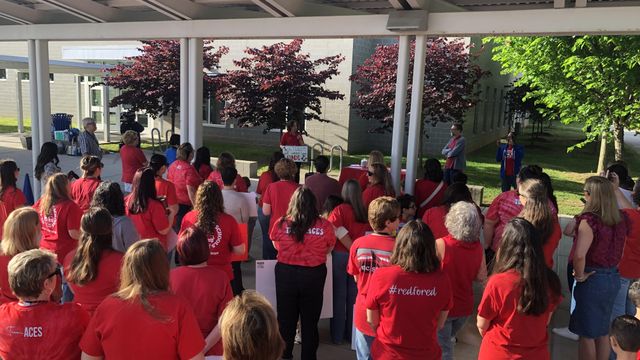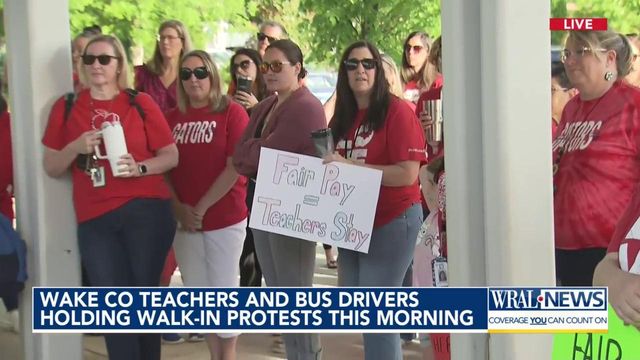Big raises for bus drivers, pay increases for other staff and teachers favored for new proposed Wake schools budget
Wake County school board members agreed to ask for a major pay increase for bus drivers Tuesday, as well as asking for smaller raises for other employees.
The school board met during a work session Tuesday and tentatively agreed to ask county commissioners for a $63.2 million budget increase next school year. They’ll officially vote to make the request during their May 7 regular board meeting.
The meeting took place just hours after demonstration for higher pay organized by the Wake chapter of the North Carolina Association of Educators, which represents teachers and other school employees.
“We’ve heard loud and clear that they are asking for that 4% increase,” Board Member Lynn Edmonds said.
The budget request includes raises for most employees:
Minimum wage increase from $18.55 per hour for bus drivers to $20 per hour, costing $1.1 million. It would amount to thousands more dollars for bus drivers next year.
Minimum wage increase to $17.75 per hour, or a 4% wage increase, for non-certified staff, such as cafeteria workers and maintenance workers. That would cost $4.1 million and amount to several hundred more dollars for employees next year.
Salary supplement increase of 4% for certified employees, such as teachers, counselors and speech language pathologists. That would cost $7.6 million and amount to a few hundred dollars next year for employees.
Board members said they expected a budget increase could require a tax increase — something the county has done in recent years as they have raised pay or increased services for other county functions, as well.
Wake County commissioners typically consider requests in May and vote on a final county budget in June. But the school system’s budget could still change, depending on what budget the North Carolina General Assembly passes during its short session this spring. The new budget year for counties and the state starts July 1.
Heagarty told board members Tuesday he believed the board need to request a less than $60 million budget increase if they hoped for commissioners to fully fund it. But board members said Tuesday they couldn’t remove one key item from the request that cost roughly $4 million: Full-time substitute teachers at each school.
Those teachers are funded currently using temporary federal pandemic relief dollars, and schools and teachers have said they are helpful when a teacher must call out. A complaint among many teachers is how often they are asked to fill in in another classroom, either for a teacher who is out or for a teaching vacancy.
“I don’t want folks to lose their jobs, especially people we’ve come to rely on,” Board Member Lindsay Mahaffey said.
‘They deserve so much more’
Earlier Tuesday, hundreds of Wake schools employees and supporters staged “walk-in” protests at seven schools and the Wake school system’s transportation center, asking for higher pay. The cost of living has risen far faster than their compensation from the state and county, they said. Meanwhile, they’re overworked.
“Teachers go above and beyond their contracted hours dedicated time for lesson planning, clubs, grading paperwork, and covering classes,” Abbotts Creek Elementary music teacher Susan Reynolds told crowd of dozens at her school Tuesday morning. “I personally spent many unpaid hours providing opportunities for my students to participate in chorus and musical performing groups.”
Caitie Duncan, a member of the school’s Parent Teacher Association and mother of two children, demonstrated Tuesday morning with her daughter and a sign that read “Show them the $$.”
Duncan got choked up talking about why she was there.
“They put so much into these kids, especially at this school,” she said, noting how hard the principal works to support teachers and create a positive school environment. “They're just really underpaid. overworked, it's not fair. They deserve so much more. We try to support them as much as we can, but there's only so much we can do to support what they need.”
In recent years, vacancy rates have been high for some employees but have improved alongside pay increases, with the exception of bus drivers. Teacher turnover has also risen, although vacancy rates in the county haven’t been much higher than 2%.
"Years of inflation and underfunding from North Carolina’s legislature has created a crisis in public education, leading to record numbers of educators leaving the field," Wake North Carolina Association of Educators President Christina Spears wrote in a press release Monday announcing the demonstrations.
Possible state-level changes
On Tuesday, Spears said she was happy with the board’s decision to raise but said the state General Assembly should contribute, too. She said lawmakers should should spend part of its expected more than $1 billion surplus on employee pay and refrain from using it to increase private school vouchers, called Opportunity Scholarships.
“They're going to put more money into Opportunity Scholarships for private schools when that money could go directly to our public schools and teachers,” Spears said.
This spring, the state had more applicants for the voucher program than funding for it, though the bulk of families left out of the program were higher-earning families. This spring was the first time families of any income and families of children who already attend private school could apply for the voucher program.
Soon, state lawmakers will convene for a short session in which state employee pay will be discussed. The state is the primary funder of education in North Carolina and sets base pay for employees. Counties can then add extra to that base pay amount.
But Wake NCAE is asking the school board and county commissioners to chip in where they say the state has left off.
Wake County Board of Education Chairman Chris Heagarty said he’s seen some recognition of the need to pay employees more among lawmakers, noting a House Select Committee on Education Reform report this spring that found teacher pay wasn’t keeping up with the cost of living and that it would need to rise to strengthen a depleting teacher workforce.
“If it requires a certain amount of money to get a college degree, and you’re going to make a limited amount of money teaching compared to other professions, it’s naturally going to shrink that pool,” Heagarty said, referring to the drop in people enrolling in teachers’ colleges.
What to cut
Not all board members agreed initially on the new proposal. Heagarty had suggested cutting the school-level substitute teachers, although he said he supported them. But cutting them would have brought the budget increase down below $60 million.
Board Member Cheryl Caulfield was among the majority of board members who didn’t want to cut those positions, arguing they supported classrooms directly. Caulfield advocating for finding more things to cut from the budget and state her support for many other academic efforts, such as even higher pay for experienced employees, more funding for tutoring and more behavioral support specialists. Caulfield has suggested looking at other ways to trim the budget to avoid needing to raise taxes, but Heagarty said the timeline was too short to take a deep look at that and suggested reorganizing a regular finance committee to study what can be changed.
Instead of looking at what to cut from existing operations, the board looked at what to cut from Superintendent Robert Taylor’s $58.3 million budget proposal.
Taylor’s proposed budget increase didn’t include pay raises. Instead, it focused on keeping substitute teachers, counselors, social workers and others who were hired using temporary federal pandemic relief dollars, which will run out by September.
In cutting from Taylor’s proposal, the board landed on cutting $2.5 million that currently supports extra pay for employees who supervise children whose buses aren’t on time, transitioning $1 million in behavioral support professionals to Medicaid, reversing a proposed reduction in student parking fees from $200 to $175, cutting some unfilled human resources positions, and using $4 million in leftover federal funds to keep some behavioral support professionals.
Other items the proposed budget will fund next year include $9.9 million in raises for locally funded employees to match state-funded employees, a $9 million in required support for charter schools, $3.8 million toward costs for a new elementary school opening in Holly Springs, and $2.3 million toward rising property costs, among other things.
Varying budget proposals
On Tuesday afternoon, board members discussed four different budget proposals that included raises and that would cost the county between $63 million and $70.2 million more next year – amounting to a more than 10% increase in county funding.
Each of the four budget proposals included a different amount of employee raises. All included $1.1 million to raise bus driver pay from $18.55 per hour starting out to $20 per hour starting out, on par with the market rate for people with commercial drivers licenses. That would amount to a few thousand more dollars per year for bus drivers – a position with a vacancy rate that keeps rising and was 36.8% in March. Thousands of children have extra early, late or missed pickups each day.
The proposed budgets also include raising other employees' hourly pay to at least $17.50 – costing $3.5 million – or as high as $18.25 per hour, costing $8.8 million. Each $0.25 increase could amount to $300 to $400 more in a year for a 10-month employee, depending on how many hours they work.
For teachers, budgets propose either a 4% increase to the local salary supplement, costing $7.6 million, or a 4.5% increase to the local salary supplement, costing $8.5 million. Each would amount to $300 to $400 more in a year for most teachers.
Vacancy rates for instructional assistants have improved alongside pay raises of several dollars per hour. The system had a 4.6% vacancy rate in March, down from as high as 11% in November 2021. For cafeteria workers, the vacancy rate was 8.2% in March, about the same as last spring. But it's been a major improvement since vacancy rates regularly topped 10% two years ago and even reached highs of 20% in 2021.
For teachers, the school system counted 1.5% of positions vacant in March, an improvement from more than 2% most of the past few school years.












